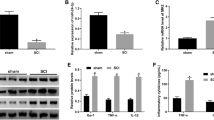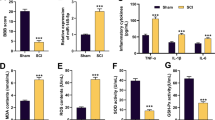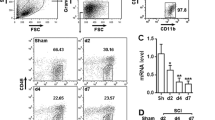Abstract
Microglial activation and inflammatory response played an important role in the secondary injury of spinal cord injury (SCI). Several microRNAs were associated with this procedure, but the underlying molecular mechanism was poorly understood. Sprague-Dawley (SD) rats were divided into four groups: SCI group (n = 7), agomiR-325-3p group (n = 7), and their control groups. Expression of miR-325-3p and proteins in epidermal growth factor receptor (EGFR)/mitogen-activated protein kinase (MAPK) signaling pathway was evaluated in microglia from SCI rats and primary microglia/BV2 cells activated by lipopolysaccharide (LPS). Concentrations of interleukin-1β (IL-1β) and tumor necrosis factor α (TNF-α) in supernatants were measured by ELISA. Low expression of miR-325-3p and activation of EGFR/MAPK was observed in microglia of SCI and LPS-induced primary microglia. Overexpression of miR-325-3p in LPS-induced BV2 cells inhibited microglial activation and release of TNF-α and IL-1β. Luciferase reporter assay confirmed that miR-325-3p negatively regulated EGFR by targeting its 3′-untranslated regions. Additionally, agomiR-325-3p inhibited the activation of microglia and EGFR/MAPK, alleviating the inflammatory response. These results indicated that miR-325-3p attenuated secondary injury after SCI through inhibition of EGFR/MAPK signaling pathway, the microglial activation, and the release of inflammatory cytokines, suggesting that miR-325-3p may be employed as a therapeutic target for SCI.






Similar content being viewed by others
References
Allen A (1911) Surgery of experimental lesion of spinal cord equivalent to crush injury of fracture dislocation of spinal column: a preliminary report. J Am Med Assoc LVII(11):878–880
Bartel DP (2004) MicroRNAs: genomics, biogenesis, mechanism, and function. Cell. 116(2):281–297
Bartholdi D, Schwab ME (1997) Expression of pro-inflammatory cytokine and chemokine mRNA upon experimental spinal cord injury in mouse: an in situ hybridization study. Eur J Neurosci 9(7):1422–1438
Basso DM, Beattie MS, Bresnahan JC (1995) A sensitive and reliable locomotor rating scale for open field testing in rats. J Neurotrauma 12(1):1–21
Beattie MS (2004) Inflammation and apoptosis: linked therapeutic targets in spinal cord injury. Trends Mol Med 10(12):580–583
Bhalala OG, Pan L, Sahni V, McGuire TL, Gruner K, Tourtellotte WG et al (2012) MicroRNA-21 regulates astrocytic response following spinal cord injury. J Neurosci 32(50):17935–17947
Center NSCIS (2018) Facts and figures at a glance. The University of Alabama at Birmingham, Birmingham
García DM, Baek D, Shin C, Bell GW, Grimson A, Bartel DP (2011) Weak seed-pairing stability and high target-site abundance decrease the proficiency of lsy-6 and other miRNAs. Nat Struct Mol Biol 18:1139–1146
Gelinas DS, McLaurin J (2005) PPAR-α expression inversely correlates with inflammatory cytokines IL-1β and TNF-α in aging rats. Neurochem Res 30(11):1369–1375
Gingras M, Gagnon V, Minotti S, Durham HD, Berthod F (2007) Optimized protocols for isolation of primary motor neurons, astrocytes and microglia from embryonic mouse spinal cord. J Neurosci Methods 163(1):111–118
Goldshmit Y, Kanner S, Zacs M, Frisca F, Pinto AR, Currie PD, Pinkas-Kramarski R (2015) Rapamycin increases neuronal survival, reduces inflammation and astrocyte proliferation after spinal cord injury. Mol Cell Neurosci 68:82–91
Gruner JA (1992) A monitored contusion model of spinal cord injury in the rat. J Neurotrauma 9(2):123–128
Guhathakurta S, Bok E, Evangelista BA, Kim YS (2017) Deregulation of alpha-synuclein in Parkinson’s disease: insight from epigenetic structure and transcriptional regulation of SNCA. Prog Neurobiol 154:21–36
Hu J-Z, Huang J-H, Zeng L, Wang G, Cao M, Lu H-B (2013) Anti-apoptotic effect of microRNA-21 after contusion spinal cord injury in rats. J Neurotrauma 30(15):1349–1360
Hwang IK, Lee CH, Li H, Yoo K-Y, Choi JH, Kim DW, Kim DW, Suh HW, Won MH (2008) Comparison of ionized calcium-binding adapter molecule 1 immunoreactivity of the hippocampal dentate gyrus and CA1 region in adult and aged dogs. Neurochem Res 33(7):1309–1315
Koistinaho M, Koistinaho J (2002) Role of p38 and p44/42 mitogen-activated protein kinases in microglia. Glia. 40(2):175–183
Li Z-W, Tang R-H, Zhang J-P, Tang Z-P, Qu W-S, Zhu W-H, Li JJ, Xie MJ, Tian DS, Wang W (2011) Inhibiting epidermal growth factor receptor attenuates reactive astrogliosis and improves functional outcome after spinal cord injury in rats. Neurochem Int 58(7):812–819
Lin T, Zhou S, Gao H, Li Y, Sun L (2018) MicroRNA-325 is a potential biomarker and tumor regulator in human bladder cancer. Technol Cancer Res Treat 17:153303381879053
Liu N-K, Wang X-F, Lu Q-B, Xu X-M (2009) Altered microRNA expression following traumatic spinal cord injury. Exp Neurol 219(2):424–429
Louw AM, Kolar MK, Novikova LN, Kingham PJ, Wiberg M, Kjems J, Novikov LN (2016) Chitosan polyplex mediated delivery of miRNA-124 reduces activation of microglial cells in vitro and in rat models of spinal cord injury. Nanomedicine 12(3):643–653
McDonald JW, Sadowsky C (2002) Spinal-cord injury. Lancet 359(9304):417–425
Nimmerjahn A, Kirchhoff F, Helmchen F (2005) Resting microglial cells are highly dynamic surveillants of brain parenchyma in vivo. Science. 308(5726):1314–1318
Panigone S, Hsieh M, Fu M, Persani L, Conti M (2008) Luteinizing hormone signaling in preovulatory follicles involves early activation of the epidermal growth factor receptor pathway. Mol Endocrinol 22(4):924–936
Pei Z, Pang H, Qian L, Yang S, Wang T, Zhang W, Wu X, Dallas S, Wilson B, Reece JM, Miller DS, Hong JS, Block ML (2007) MAC1 mediates LPS-induced production of superoxide by microglia: the role of pattern recognition receptors in dopaminergic neurotoxicity. Glia. 55(13):1362–1373
Popovich PG, Horner PJ, Mullin BB, Stokes BT (1996) A quantitative spatial analysis of the blood–spinal cord barrier: I. Permeability changes after experimental spinal contusion injury. Exp Neurol 142(2):258–275
Qiao F, Atkinson C, Song H, Morgan BP, Tomlinson S (2010) The alternative and terminal pathways of complement mediate post-traumatic spinal cord inflammation and injury. Am J Pathol 177(6):3061–3070
Qu W-S, Tian D-S, Guo Z-B, Fang J, Zhang Q, Yu Z-Y et al (2012) Inhibition of EGFR/MAPK signaling reduces microglial inflammatory response and the associated secondary damage in rats after spinal cord injury. J Neuroinflammation 9:178–192
Toledano Furman NE, Prabhakara KS, Bedi S, Cox CS, Olson SD (2017) OMIP-041: optimized multicolor immunofluorescence panel rat microglial staining protocol. Cytometry A 93(2):182–185
Tonai T, Shiba K-i, Taketani Y, Ohmoto Y, Murata K, Muraguchi M et al (2001) A neutrophil elastase inhibitor (ONO-5046) reduces neurologic damage after spinal cord injury in rats. J Neurochem 78(5):1064–1072
Yan H, Hong P, Jiang M, Li H (2012) MicroRNAs as potential therapeutics for treating spinal cord injury. Neural Regen Res 7(17):1352–1359
Yang Y, Sun B, Huang J, Xu L, Pan J, Fang C, Li M, Li G, Tao Y, Yang X, Wu Y, Miao P, Wang Y, Li H, Ren J, Zhan M, Fang Y, Feng X, Ding X (2017) Up-regulation of miR-325-3p suppresses pineal aralkylamine N-acetyltransferase (Aanat) after neonatal hypoxia–ischemia brain injury in rats. Brain Res 1668:28–35
Yao S, Zhao T, Jin H (2015) Expression of MicroRNA-325-3p and its potential functions by targeting HMGB1 in non-small cell lung cancer. Biomed Pharmacother 70:72–79
Zhang L-L, Lu Y-M, Zhang L-F (2018) MiR-449b inhibits the migration and invasion of colorectal cancer cells through the negative regulation of MMP2. Clin Surg Res Commun 2(3):28–34
Zhou Z, Peng X, Insolera R, Fink DJ, Mata M (2009) IL-10 promotes neuronal survival following spinal cord injury. Exp Neurol 220(1):183–190
Zhou X, He X, Ren Y (2014) Function of microglia and macrophages in secondary damage after spinal cord injury. Neural Regen Res 9(20):1787–1795
Zhou H-J, Wang L-Q, Xu Q-S, Fan Z-X, Zhu Y, Jiang H, Zheng XJ, Ma YH, Zhan RY (2016) Downregulation of miR-199b promotes the acute spinal cord injury through IKKβ-NF-κB signaling pathway activating microglial cells. Exp Cell Res 349(1):60–67
Availability of Data and Material
The datasets used and/or analyzed during the current study are available from the corresponding author on reasonable request.
Funding
None.
Author information
Authors and Affiliations
Corresponding author
Ethics declarations
Ethics Approval and Consent to Participate
All experimental procedures were performed in accordance with protocols approved by the Governmental Animal Care Committee of the First Affiliated Hospital of Zhengzhou University.
Conflict of Interests
The authors declare that they have no conflict of interests.
Additional information
Publisher’s Note
Springer Nature remains neutral with regard to jurisdictional claims in published maps and institutional affiliations.
Rights and permissions
About this article
Cite this article
Yan, P., Wu, X., Liu, X. et al. A Causal Relationship in Spinal Cord Injury Rat Model Between Microglia Activation and EGFR/MAPK Detected by Overexpression of MicroRNA-325-3p. J Mol Neurosci 68, 181–190 (2019). https://doi.org/10.1007/s12031-019-01297-w
Received:
Accepted:
Published:
Issue Date:
DOI: https://doi.org/10.1007/s12031-019-01297-w




